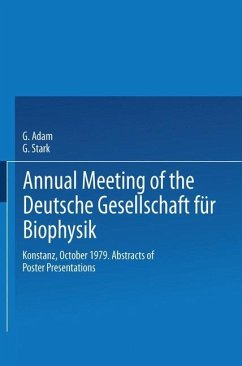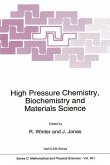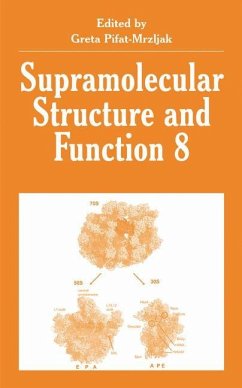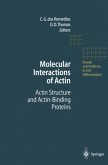Section A: Molecular Biophysics.- A1 7-cis retinal, an artificial chromophore of bacteriorhodopsin.- A2 On the determination of the absorption spectra of some 11-cis-retinal conformeres by polarisation spectroscopy using extremely thin crystal plates.- A3 Resonance CARS spectroscopy of bacteriorhodopsin.- A4 Kinetic infrared spectroscopy on the photocycle of bacteriorhodopsin.- A5 Kinetic infrared investigation on the photodissociation of sperm whale CO-myoglobin.- A6 Some theoretical and practical aspects of enzyme immobilisation at the example urease / activated aluminiumhydroxide.- A7 Kinetic of urease-catalysed urea hydrolysis in the presence of alkaline earth halides.- A8 Ion atmosphere relaxation of simple electrolytes and polyionic biopolymers in electric fields.- A9 High-resolution temperature-jump measurements in biochemistry.- A10 Demonstration of G¿U wobble base pairs by Raman and IR spectroscopy.- A11 A new model for the activation and inactivation of neocarzinostatin, an antitumor protein.- A12 Generation of pre-neocarzinostatin and its antagonistic effect on neocarzinostatin-induced DNA strand scission.- A13 The production of strand breaks by the interaction of bleomycin with supercoiled col E1 DNA: An unexpected concentration dependence.- A14 Electron spin resonance study of cobalt leghaemoglobin.- A15 Interactions of ATP phosphate groups with amines and divalent metal ions: 31P-NMR studies.- A16 Investigations on the interaction of NADH with Cu(II): ESR and optical absorption spectroscopy.- A17 Experiments on the reaction kinetics between ¿platinum blue¿ compounds and several biomolecules.- A18 Investigations on the molecular interaction of the anti carcinogenic compound cis-dichlorodiammineplatinum (II): The formation of colored platinum complexes.- A19 Modification of the radiation effect on nucleobases and nucleosides by nitroimidazole-derivatives and ascorbic acid.- A20 Radikalerzeugung in Einkristallen decarboxylierter aromatischer Aminos¿en.- Section B: Cell- and Membrane Research.- B1 Polymorphism of pure and mixed phospholipid monolayers.- B2 Spectroscopic investigations of macroscopically ordered lecithin ¿ water ¿ multibilayers.- B3 Neutron small angle scattering on model membranes.- B4 Kinetic investigations of the phase transition of lecithin bilayers.- B5 The interaction between L-ascorbic acid, ?-tocopherol, and phospholipid model membranes.- B6 The interaction of synthetic phospholipids with melittin as a model to study lipid-protein interactions.- B7 Einflu¿k¿nstlicher Ionophore auf die Struktur von Modellmembranen.- B8 31-P-NMR studies on the lipid containing bacteriophage PM2.- B9 The head group mobility in phosphatidylcholine membranes in the presence of cholesterol as seen by a dielectric investigation.- B10 A time averaged picture of the conformation and segmental. disorder of phosphatidylcholine in bilayers investigated by neutron diffraction.- B11 Determination of lipid order parameters from fluorescence depolarization experiments.- B12 Lipid-protein interactions in bacteriorhodopsin-phosphatidylcholine vesicles.- B13 Aggregated and monomeric bacteriorhodopsin pumps protons.- B14 On the interpretation of lipid membrane cooperativity data.- B15 Statistical description of phospholipid bilayers with application to deuterium NMR.- B16 Structural order of lipids and proteins in membranes. New evaluation of fluorescence anisotropy data.- B17 New measurements of the water-permeability across lipid bilayer vesicles, the effect of cholesterol.- B18 Investigations of lipoid pH indicators as probes for electrostatic potential of micelles and vesicles.- B19 A. Influence of cholesterol on permeability and structural properties of artificial membranes containing enantiomeric phosphatidylcholines and ether analogues.- B20 Surface potential studies of monolayers from different sterols and various phospholipid / sterol mixtures.- B21 Influence of surface potential on ion transport through lipid bilayer membranes.- B22 Influence of local anesthetics on ion transport through lipid bilayer membranes.- B23 Negative hydrophobic ions as carriers for positive hydrophobic ions.- B24 Laser-temperature-jump method for the determination of the rate of desorption of hydrophobic ions in lipid membranes.- B25 Voltage dependent noise current of lipid bilayer membranes generated by hydrophobic ions.- B26 Noise analysis of carrier-mediated ion transport under nonequilibrium conditions.- B27 1 / f noise in track-etched mica membranes.- B28 Current fluctuations in biological transport systems far from equilibrium.- B29 Ion transport through pores: oscillatory phenomena at transient states.- B30 Why single file pores?.- B31 Properties of ionic channels made from derivatives of gramicidin A.- B32 State dependent blocking effects on the alamethicin pore by divalent cations.- B33 Structural requirements for membrane modifying activity in alamethicin-type antibiotics.- B34 Investigations on monolayers of alamethicin-type antibiotics at an air / water interphase.- B35 Transport of matter through membranes. The influence of protein on the kinetics of the free dialysis of detergents.- B36 Vesicle spread membranes, a novel way for membrane reconstitution.- B37 Matrix protein / ATPase proteolipid / acetylcholine receptor in vesicle spread membranes.- B38 Formation and characterization of bilayer membranes from vesicle-spread monolayers.- B39 Studies on photocurrent kinetics of purple membrane on black lipid membranes.- B40 Association equilibria between oligomers of band 3-protein from human erythrocyte membranes: Time needed for relaxation towards equilibrium.- B41 Properties of large ion-permeable pores formed by porins from Salmonella typhimurium in lipid bilayer membranes.- B42. Reversible electrical breakdown of lipid bilayer membranes.- B43 Dependence of the electrical breakdown voltage on the charging time in Valonia utricularis.- B44 Interaction of burn toxin with liver cells and artificial lipid bilayer membranes.- B45 Development of a new Coulter counter system: Measurement of the volume, internal conductivity, and dielectric breakdown voltage of a single guard cell protoplast of Vicia faba and tumor cells.- B46 Guard and mesophyll cell protoplasts of Vicia faba: Plasmalemma ultrastructure.- B47 X-ray diffraction and electronmicroscopic studies of thylacoid membranes.- B48 On the transmembrane electrical potential difference in chloroplasts studied by electrochromism.- B49 Study of the electron- and proton transport in inside-out thylakoids.- B50 Initial kinetics of ATP-synthesis and of conformational changes in the chloroplast ATPase studied by external electric field pulses.- B51 Rapid kinetics of ATP-synthetis in chloroplasts by acid / base transition.- B52 Demonstration of electrical surface charge effects at the inner side of the thylakoid membrane.- B53 Ammonium transport in the plasma membrane of Riccia fluitans.- B54 Effect of anti-microtubule herbicides on Ca2+ transport and energy transduction in plant mitochondria.- B55 Evaluation of the electrondensity profile of the frog ROS-disk membrane in vivo using X-ray diffraction.- B56 Surface potentials in intact cattle rod outer segments.- B57 On the protein composition of bovine rod outer segment disk membranes.- B58 Structural consequences of magnesium ATP-ase activity in bovine rod outer segment disk membranes.- B59 Flash spectroscopic studies on electrophysiologically intact bovine retinae.- B60 Chemical control of membrane transport by the acetylcholine receptor system.- B61 Discrete current fluctuations produced by single K+-channels in the squid axon membrane.- B62 The effect of high extracellular potassium on the kinetics of potassium conductance of the squid axon membrane.- B63 Effect of GABA on non-synaptic potassium channels in crayfish muscle.- B64 Excitatory synaptic current noise in crayfish muscle fibres.- B65 The Schwann cell sheath modifies the dielectric properties of squid axon preparations.- B66 Ion-selectivity of voltage- and of mechano-sensitive membrane channels in Stylonychia.- B67 Functional separation of subcellular sensitive elements by selective adaptation in a ciliary mechanoreceptor cell.- B68 Optical monitoring of membrane potential changes as a tool to study sodium-dependent substrate transport in brush border vesicles from kidney proximal tubules.- B69 Is the spontaneous leak found in the resealed ghost related to the Gardos effect?.- B70 Transformed cells differ from normal cells by the topological arrangement of the outer cell membrane.- B71 Fluorescence polarization of 3T3 and SV40-3T3 cells thinly spread on their growth substrate.- B72 The effect of bleomycin on V 79-spheroids.- B73 Disturbance of proliferation kinetics of L-cells by 3H-thymidine labeling.- B74 Scanning electron microscopic measurement of human red blood cell diameter alterations as a function of cell age.- B75 Influence of reducing and oxidizing substances on healthy and ¿leukemic¿ blood and its fractions.- B76 Interaction between ascorbic acid and Cu-proteins: Atomic absorption and ESR measurements on erythrocyte ghosts and blood plasma.- B77 Organ specific application of drugs by means of cellular capsule systems.- B78 Investigation of biophysical parameters in deep freezing experiments with plant cells in order to achieve a high rate of surviving frost sensitive cells.- B79 Natural electric currents traverse growing plant cells and tissues.- B80 Selective accumulation of alkali-metal ions at cellular protein sites without ion pumps.- Section C: Neurobiology and Cybernetics.- C1 Exchange of solutes between superfusate and the extra-cellular compartment adjacent to the photosensory membrane of Limulus and crayfish photoreceptor.- C2 Laser-microprobe-mass-spectrometry reveals two classes of shielding pigment in the Astacus retina: Ome binding large amounts of Ca, the other binding Na and K..- C3 Light-induced calcium release from bovine disk vesicles.- C4 The kinetic behaviour of rapid calcium release in cattle rod outer segments: The metarhodopsin I / metarhodopsin II-transition is involved in the trigger mechanism.- C5 Calcium-containing and calcium-accumulating structures in photoreceptor cells of the leech Hirudo medicinalis.- C6 Effects of extracellular Ca++ on the response of photo- receptor cells of Hirudo medicinalis.- C7 Time course and temperature dependence of the light induced alkalisation effect in bovine rod outer segments.- C8 Evidence for light induced lateral contraction of the disk membrane by small bleachings of rhodopsin (a more detailed interpretation of the ¿P-signal¿).- C9 Electrical properties of the external limiting membrane in the receptor layer of the frog retina.- C10 Mechanism of photoresponse generation in isolated frog rod outer segments.- C11 Chemoreception in the crayfish Orconectes limosus.- Section D: Radiation Biophysics.- D1 A simple irradiation facility with protons.- D2 The autoradiolytic and the gamma-induced demethylation of thymine in aqueous solution.- D3 Measurement of irreparable double-strand breaks in the DNA of eukaryotic cells.- D4 The oxygen enhancement ratio for single- and double-strand breaks induced by tritium incorporated in DNA of cultured human kidney cells.- D5 Repair of DNA strand breaks in CHO cells after low doses of X-rays.- D6 UV excision repair in lens epithelial cells during aging in vitro.- D7 Radiation induced protein-DNA crosslinks in eucaryotic cells.- D8 The effect of long-wavelength UV on BrUra substituted E. coli: Correlation between survival, strand breaks, and BrUra-incorporation.- D9 Correlation between enhanced radioresistance of spheroid cells and cell coupling.- D10 Influence of X-irradiation on the rosette-forming capacity of human lymphocytes.- D11 Observations in synchronized yeast cells (Sacch. uv. ) during X-ray-induced giant cell formation.- D12 Repair and recovery in irradiated yeast ¿ the effect of protein synthesis inhibitors on liquid holding recovery in X-irradiated yeast.- D13 Repair and recovery in irradiated yeast. Mutation induction by ionizing radiation: Influence of oxygen and LET.- D14 Repair and recovery in irradiated yeast. Excision repair of yeast DNA after exposure of UV (254 nm).- D15 Repair and recovery in irradiated yeast. Lethal and mutagenic effects of 254 nm- and 313 nm-radiation on yeast strains of different repair capabilities.- D16 Repair and recovery in irradiated yeast. Survival and mutation induction by heavy ions in yeast cells of different radiosensitivity.- D17 The kinetic of yeast cells within the first four generations after irradiation with ionizing particles.- D18 The possible role of c-AMP in the irradiation induced contraction of nerve muscle preparation.- D19 Irradiation and gastric emptying.- D20 The effect of neutron- and X-irradiation on the development of preimplanted mouse embryos.- D21 Immediate effects of ionizing radiation in rabbits.- D22 Interaction of 40,5¿C-hyperthermia with 200 kV X-rays at two different dose-rates.- D23 Late effects from low LET radiation in the low dose range ¿ the experience of Hiroshima and Nagasaki.- D24 A non-linear model of the global carbon cycle for the assessment of long-term effects of CO2 and C-14 due to various energy scenarios.








